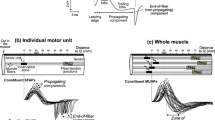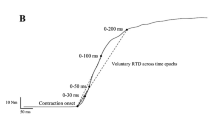Abstract
Introduction
The effects of muscle contractions on muscle fibre conduction velocity have normally been investigated for contractions of a given duration and intensity, with most studies being focused on the decline on conduction velocity during/after prolonged contractions. Herein, we perform a systematic analysis of the changes in conduction velocity after voluntary contractions of different durations and intensities.
Methods
Conduction velocity was estimated in the vastus lateralis before and after knee extensor isometric maximal voluntary contractions (MVCs) of 1, 3, 6, 10, 30 and 60 s, and after brief (3 s) contractions at 10, 30, 50, 70, and 90% of MVC force. Measurements were made during the 10-min period following each contraction.
Results
(1) Conduction velocity was increased immediately after (1 s) the MVCs of brief (≤ 10 s) duration (12 ± 2%, P < 0.05), and then returned rapidly (within 15 s) to control levels; (2) the extent of the increase in conduction velocity was similar after the 3-s, 6-s, and 10-s MVCs (P > 0.05); (3) the magnitude of the increase in conduction velocity after a brief contraction augmented with the intensity of the contraction (increases of 4.6, 7.7, 11.4, 14.8, and 15.2% for contractions at 10, 30, 50, 70, and 90% of MVC force, respectively); (4) conduction velocity was not decreased immediately after the 30-s MVC (P > 0.05); and (5) conduction velocity did not reach its minimum 1 s after the long (≥ 30 s) MVCs.
Conclusions
Brief (≤ 10 s) muscle contractions induce a short-term increase in conduction velocity, lasting 15 s, while long (≥ 30 s) contractions produce a long-term decrease in conduction velocity, lasting more than 2 min.





Similar content being viewed by others
Abbreviations
- DurPP :
-
Peak-to-peak duration of the M-wave
- Fmedian:
-
Median frequency of the M-wave
- EMG:
-
Electromyographic
- MVC:
-
Maximal voluntary contraction
References
Aidley DJ (1998) The physiology of excitable cells, 4th edn. Cambridge University Press, Cambridge
Alway SE, Hughson RL, Green HJ, Patla AE, Frank JS (1987) Twitch potentiation after fatiguing exercise in man. Eur J Appl Physiol 56:461–466
Andreassen S, Arendt-Nielsen L (1987) Muscle fibre conduction velocity in motor units of the human anterior tibial muscle: a new size principle parameter. J Physiol 391:561–571
Brody LR, Pollock MT, Roy SH, De Luca CJ, Celli B (1991) pH-induced effects on median frequency and conduction velocity of the myoelectric signal. J Appl Physiol 71:1878–1885
Broman H, Bilotto G, De Luca CJ (1985) Myoelectric signal conduction velocity and spectral parameters: influence of force and time. J Appl Physiol 58(5):1428–1437
Christova P, Kossev A, Kristev I, Chichov V (1999) Surface EMG recorded by branched electrodes during sustained muscle activity. J Electromyogr Kinesiol 9(4):263–276
Cupido CM, Galea V, McComas AJ (1996) Potentiation and depression of the M wave in human biceps brachii. J Physiol 491:541–550
Farina D, Fosci M, Merletti R (2002) Motor unit recruitment strategies investigated by surface EMG variables. J Appl Physiol 92(1):235–247
Farina D, Arendt-Nielsen L, Graven-Nielsen T (2005a) Effect of temperature on spike-triggered average torque and electrophysiological properties of low-threshold motor units. J Appl Physiol 99:197–203
Farina D, Gazzoni M, Camelia F (2005b) Conduction velocity of low-threshold motor units during ischemic contractions performed with surface EMG feedback. J Appl Physiol 98:1487–1494
Fortune E, Lowery MM (2009) Effect of extracellular potassium accumulation on muscle fibre conduction velocity: a simulation study. Ann Biomed Eng 37:2105–2117
Fortune E, Lowery MM (2012) Effect of membrane properties on skeletal muscle fibre excitability: a sensitivity analysis. Med Biol Eng Comput 50(6):617–629
Hakansson CH (1956) Conduction velocity and amplitude of the action potential as related to circumference in the isolated fibre of frog muscle. Acta Physiol Scand 37(1):14–34
Hodges PW, Pengel LH, Herbert RD, Gandevia SC (2003) Measurement of muscle contraction with ultrasound imaging. Muscle Nerve 27(6):682–692
Homma S, Iwata K, Kusama T, Nakajima Y (1983) Effects of electrical constants on conduction velocity of action potentials measured with unidimensional latency-topography in frog skeletal muscle fibres. Jpn J Physiol 33(5):711–720
Juel C (1986) Potassium and sodium shifts during in vitro isometric muscle contraction, and the time course of the ion-gradient recovery. Pflugers Arch 406(5):458–463
Juel C (1988) Muscle action potential propagation velocity changes during activity. Muscle Nerve 11:714–719
Kössler F, Lange F, Caffier G, Küchler G (1991) External potassium and action potential propagation in rat fast and slow twitch muscles. Gen Physiol Biophys 10(5):485–498
Lateva ZC, McGill KC, Burgar CG (1996) Anatomical and electrophysiological determinants of the human thenar compound muscle action potential. Muscle Nerve 19(11):1457–1468
Mademli L, Arampatzis A (2005) Behaviour of the human gastrocnemius muscle architecture during submaximal isometric fatigue. Eur J Appl Physiol 94(5–6):611–617
Martin AR (1954) The effect of change in length on conduction velocity in muscle. J Physiol 125(1):215–220
Masuda T, Miyano H, Sadoyama T (1985) The position of innervation zones in the biceps brachii investigated by surface electromyography. IEEE Trans Biomed Eng 32:36–42
Naeije M, Zorn H (1983) Estimation of the action potential conduction velocity in human skeletal muscle using the surface EMG cross-correlation technique. Electromyogr Clin Neurophysiol 23(1–2):73–80
Overgaard K, Nielsen OB, Clausen T (1997) Effects of reduced electrochemical Na+ gradient on contractility in skeletal muscle: role of the Na+–K+ pump. Pflugers Arch 434(4):457–465
Rodriguez-Falces J, Place N (2016) Differences in the recruitment curves obtained with monopolar and bipolar electrode configurations in the quadriceps femoris. Muscle Nerve 54(1):118–131
Rodriguez-Falces J, Place N (2017) New insights into the potentiation of the first and second phases of the M-wave after voluntary contractions in the quadriceps muscle. Muscle Nerve 55(1):35–45
Rodriguez-Falces J, Place N (2018) End-of-fibre signals strongly influence the first and second phases of the M wave in the Vastus Lateralis: implications for the study of muscle excitability. Front Physiol 9:162
Rodriguez-Falces J, Navallas J, Malanda A, Rodriguez-Martin O (2014) Comparison of the duration and power spectral changes of monopolar and bipolar M waves caused by alterations in muscle fibre conduction velocity. J Electromyogr Kinesiol 24:452–464
Saltin B, Sjogaard G, Strange S, Juel C (1987) Redistribution of K+ in the human body during muscular exercise; its role to maintain whole body homeostasis. In: Shiraki K, Yousef MK (eds) Man in stressful environments. Thermal and work physiology. Thomas, Springfield, IL, pp 247–267
Schmitz JP, van Dijk JP, Hilbers PA, Nicolay K, Jeneson JA, Stegeman DF (2012) Unchanged muscle fibre conduction velocity relates to mild acidosis during exhaustive bicycling. Eur J Appl Physiol 112:1593–1602
Schneider J, Silny J, Rau G (1988) Noninvasive measurement of conduction velocity in motor units influenced by temperature and excitation pattern. In: Wallinga W, Boom HBK, DeVries J (eds) Electromyographical kinesiology. Elsevier, Amsterdam, pp 251–254
Stålberg E (1966) Propagation velocity in human muscle fibres in situ. Acta Physiol Scand Suppl 287:1–112
Stulen FB, DeLuca CJ (1981) Frequency parameters of the myoelectric signal as a measure of muscle conduction velocity. IEEE Trans Biomed Eng 28:515–523
Troni W, Cantello R, Rainero I (1983) Conduction velocity along human muscle fibres in situ. Neurology 33(11):1453–1459
Van der Hoeven JH, van Weerden TW, Zwarts MJ (1993) Long-lasting supernormal conduction velocity after sustained maximal isometric contraction in human muscle. Muscle Nerve 16:312–320
Vyskocil F, Hník P, Rehfeldt H, Vejsada R, Ujec E (1983) The measurement of K+ concentration changes in human muscles during volitional contractions. Pflugers Arch 399:235–237
Funding
No grants are declared. I declare that the authors have no financial interests.
Author information
Authors and Affiliations
Contributions
JR-F and NP designed the experimental study; JR-F performed the experiments; J R-F analysed the data; J R-F and NP interpreted the results of experiments; J R-F drafted the manuscript; J R-F and NP edited and revised the manuscript; JR-F and NP approved the final version of manuscript.
Corresponding author
Ethics declarations
Conflict of interest
I declare that the authors have no conflict of interest.
Additional information
Communicated by Olivier Seynnes.
Publisher's Note
Springer Nature remains neutral with regard to jurisdictional claims in published maps and institutional affiliations.
Supplementary Information
Below is the link to the electronic supplementary material.
Rights and permissions
About this article
Cite this article
Rodriguez-Falces, J., Place, N. Muscle fibre conduction velocity varies in opposite directions after short- vs. long-duration muscle contractions. Eur J Appl Physiol 121, 1315–1325 (2021). https://doi.org/10.1007/s00421-021-04613-8
Received:
Accepted:
Published:
Issue Date:
DOI: https://doi.org/10.1007/s00421-021-04613-8




